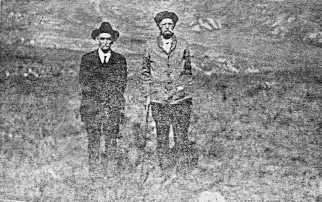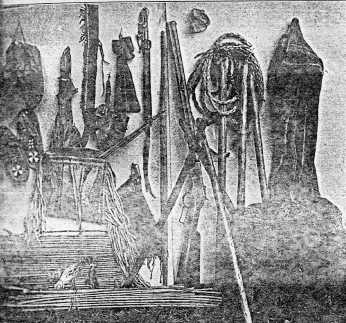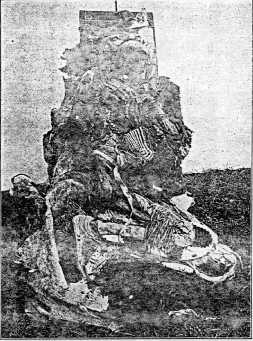|
|
59 |

Pawnee-Sioux Battlefield in Massacre Canyon, Hitchcock
County.
J. W. Williamson (right), and Captain Lute H. North (left) in
foreground.
Photo by A. E. Sheldon, October 15, 1921.
|
56 |
|
leader of the Pawnee, had answered. "the White men wish the
Pawnee to leave the buffalo for them to kill. The Great Father
gave us leave to hunt for three moons. We will make one more drive
of buffalo and then return with plenty of meat to our village on
the Loup."
A mile long that early August morning the Pawnee
nation trailed across the divide, going northeast. Soon buffalo
were seen coming from the northwest over the crest of the hill
toward the Pawnee. Eagerly the Pawnee hunters rode out to the
chase. As they approached the buffalo a transformation took place.
Part of the buffalo became, by throwing off the buffalo robes
which concealed them, a band of Sioux riding in wide war circles
and shooting at the Pawnee.
"There's only a few Sioux. We can whip them"
shouted the Pawnee chiefs as they summoned their fighting men.
Near at hand was a deep ravine. Into it were hurried the Pawnee
women, children, dogs and pack ponies. As they sought refuge there
the skyline to the north and west swarmed with hostile Sioux.
Round they rode in circles firing as they rode.
There were two white men with the Pawnee camp,
one a young man from the east who had begged to go on the hunt.
When he saw the Sioux, he fled. Williamson, the other white man
bore the written authority of the United States to conduct the
Pawnee on their hunt, and to preserve peace. The Sioux chiefs had
signed a treaty of peace at Fort Laramie five years before. In
their own camp at this very time was Nick Janis, of French
descent, married to a Sioux squaw and comissioned in the same
manner as Williamson to conduct Sioux buffalo hunt and keep the
peace.
Williamson tied a handkerchief at the end of a
pole, raised it and rode out to stop the Sioux, hoping that the U.
S. commission which he held could effect this. A shower of arrows
and bullets from the circling warriors showed how vain the hope.
Sky Chief, leader of the Pawnee, had before the onset of the Sioux
dashed off in pursuit of a buffalo to a ravine far to the
northeast and there was killed and scalped without knowledge of
the desperate situation of his people. As Williamson rode back a
bullet struck his pony. The poor beast stumbled on a few more
yards and fell at the edge of the ra-
|
|
57 |
vine which sheltered the Pawnee women and children. As he
stripped the saddle from the dying pony he swept the battlefield
with one searching glance which forever fixed it in his
memory:
On either flank the Sioux warriors were rapidly
advancing to envelope the Pawnee.
Below in the fork of the canyon, the Pawnee
women were standing in a circle with arms uplifted chanting the
ancient tribal song--a prayer for victory.
Wave upon wave of Sioux warriors circled nearer
and nearer. Arrows and bullets flew thick and fast. The plains
filled with hundreds of Sioux. The Pawnee warriors were everywhere
driven back. A desperate situation surely for Williamson and his
Pawnee.
No chanted prayer to Tirawa availed in that
desperate hour. "Fly from the Sioux" rose the cry in the ravine,
for their enemy was upon them. Cutting packs and tepee poles loose
from their ponies the disastrous flight down the ravine began.
Some, warriors and women, refused to fly. They sought refuge in
deep holes dug by the flood torrents in the bottom of the ravine.
Everyone of these was cut off and scalped. The larger part of the
Pawnee who perished were found on this part of the
battlefield.
Three miles Massacre Canyon winds to the point
where it opens into the Republican valley. Headlong toward this
opening the Pawnee camp fled. All was confusion. Warriors, squaws,
children, dogs, ponies in a mingled mass. Along the bluff rode the
Sioux firing into the fugitives below. The bottom of the ravine
where the fight began is 150 yards wide. Half a mile below it
narrows to a gorge barely wide enough for a trail. Here the flood
of humanity and beasts choked the gorge and many perished. Farther
down a similar gorge was the cause of another slaughter.
An incident of this flight is burned into Mr.
Williamson's memory. A little Indian baby, two or three years old,
had fallen from her mother's back and stretched but her hands in
vain to the panic-stricken rout begging to be taken with them.
After the fight a number of partly burned bodies of Pawnee
|
58 |
|
children were found near this place. The Sioux had
evidently stacked them up and tried to obliterate them.
Probably every Pawnee would have perished had it
not been for the appearance of a column of United States Cavalry
coming up the Republican Valley, bearing at its head the old flag.
From the hilltop the Sioux warriors spied this sooner than the
Pawnee fleeing down the ravine, and checked the pursuit.
As the mob of Pawnee warriors, squaws, children,
dogs and ponies poured out of the mouth of Massacre Canyon into
the broad valley of the Republican the pursuing Sioux rounded up
several hundred loose Pawnee ponies and vanished with them over
the hills to the north.
The army officers urged that the remaining
Pawnee return to the battlefield under cavalry escort and retake
abandoned food and equipage. To this they would not listen.
They said the food would be poisoned and the
equipment destroyed. The Pawnee nation suffered in this battle the
most terrible defeat by the Sioux in its tribal history. One
hundred and fifty-six had perished. Most of their ponies and camp
outfit was lost. Nothing for them to do but to go back to the old
home on the Loup overwhelmed with the most terrible disaster they
had known. The grief of the survivors was heart rending. The
squaws wailed the lamentation for the dead. The stolid warriors
tore their hair while tears ran do their faces. In distress,
hunger and humiliation those who escaped turned their faces
homeward, never again to return on their tribal hunt in the
Republican Valley.
Forty-eight years is a long time in the life of
the frontier. On the morning of October 15, 1921 we were on the
battle field. From every quarter across the divide came
automobiles concentrating on the canyon where the battle began.
Hundreds of men, women and children thronged the hillsides looking
down the dark ravine where the pride of the Pawnee were crushed by
the Sioux. A platoon of boy scouts from Trenton eagerly scanned
the sod finding a few fragments from the far off fight. Editors of
newspapers from Trenton and Culbertson were there. A thin thread
of smoke along the Republican Val-
|
|
59 |

Pawnee-Sioux Battlefield in Massacre Canyon, Hitchcock
County.
J. W. Williamson (right), and Captain Lute H. North (left) in
foreground.
Photo by A. E. Sheldon, October 15, 1921.
ley was evidence of the Burlington fast mail bound for Denver.
At the canyon's edge stood Scout Williamson and Captain North,
near the spot where Williamson's pony was shot from under him in
the battle. Below were the forks of the canyon where the Pawnee
women stood with bare heads under that August sun of 1873 and
chanted their prayer--the old time Pawnee prayer for victory.
Alas, not the only women who have prayed for victory in war, for
the life of their soldiers, In vain!
We gathered in eager group at the canyon's edge
and listened to Williamson tell the story of the last battle
between the Sioux and Pawnee nations. He had told it many times
since he saw it, but never before as he told it that October
morning for his feet were on the battlefield, his eyes ranging the
hills where the hostile Sioux charged and circled. Below in the
forks of the canyon stood a fleet of automobiles. The
|
60 |
|
sympathetic ear listened as though to catch the chant of the
Pawnee women. The Past and the Present were blended while we
listened to the story and renewed the recollections of the old
Nebraska days.
Never again on Nebraska prairies the useless
feud of red men fighting each other for buffalo hunting ground. To
the historian, the novelist, the poet, the dramatist belong those
years of romance and mystery. All too soon the last eye that saw
them will be closed, the last witness which told their tale will
be silent.
Here some day shall arise a monument fit to halt
the traveler's journey and claim his attention and sympathy. Upon
its granite shoulder shall be deeply cut an inscription reminding
the generations yet to be of these tribes which once found home
upon these plains, of their customs, their religion, the arts,
their struggles, and of this last great conflict between the two
greatest of these Nebraska tribes--the Pawnee and the Sioux.
|
|
61 |

War Outfit of Cheyenne Chief as he came into Historical Society
Rooms
October 28, 1921.
A REVENANT CHEYENNE
In the afternoon of October 28, 1921, a
Cheyenne chief came into my office in the State Historical Society
rooms, Lincoln, Nebraska. I was startled. It was many moons since
I had seen a Cheyenne, many more since I had seen one in the full
panoply of war. Recollections of scenes at Pine Ridge during the
stormy winter of 1890-91 came back in a flash.
This Cheyenne was unmistakably fully equipped
for the war path. It was the old time war costume--rarely seen
today--that he wore. His equipment included one of the most.
|
62 |
|
complete outfits for a long and hard campaign I had seen in
many years contact with Indians. Every article was of the finest
workmanship, hand-sewed with sinew, in perfect condition. His
outfit included a war tepee, (three poles and buffalo skin
covering); a woven willow mattress to protect the warrior's body
from the wet ground when he slept; exquisite buckskin beaded
leggings; two pairs of moccasins, one fur-lined for winter; a
parfleche bag for provisions; a medicine bag with the old time
punk, flint and steel for starting fire; a pipe case for the pipe
that befits a chieftain; a mink skin charm bag with trinkets to
protect from adverse spirits; a raw hide quirt worn on the wrist;
a buffalo hoof rattle for the war dance; a braided raw hide lariat
for his pony with headstall and knot to guide.
He was tall--this Cheyenne--over six feet--as
tall as his great compatriot Roman Nose killed in Forsyth's fight
at Beecher Island in September, 1868. He was thin. His skin was
shrunken on his athletic frame. On his fingers and wrists were
rings and bracelets of former days. His black hair was closely
braided in a long queau down his back. He had both the new and the
old Cheyenne weapons--a sixteen shooter Henry rifle ready for use,
a five foot bow with the Cheyenne magical number (four) of steel
tipped arrows. He was ready for a winter campaign, for his outfit
included six of the finest buffalo robes and a cavalry officer's
heavy storm coat with high collar protecting the neck and
ears.
|
|
63 |
columns marching by different routes were to meet him there and
crush the hostiles.
It was a campaign of miscalculation and failure
for the United States army. A cavalry column of two thousand under
General Cole wandered in the Bad Lands, lost nearly all its
horses, burned its equipment and was rescued from a starving
condition by Major Frank North and his Nebraska Pawnee Scouts. The
other columns failed to reach the rendezvous on Powder river. In
the fall the troops marched back to their bases, leaving the Sioux
and Cheyenne in possession of the northern plains.
In midsummer of this campaign (July 25, 1866) an
attack was made on the stockade at Platte River Bridge, on the
Overland Trail, about thirty miles above where now stands the city
of Casper, Wyoming. It was made with the usual plains Indian
strategem. A small body of warriors rode near the fort to entice
the soldiers out. The main fighting force of warriors--near 3,000
strong--was concealed in the hills. The soldiers came out of the
fort gate, but refused to follow the retreating Indians into the
ambuscade. Instead they shelled the hills with a howitzer.
Late in the afternoon the head chiefs sent High
Backed Wolf, one of the Leading Cheyenne--to order return of the
advance party since they could not draw the soldiers into the
trap. One of the advance warriors spoke angrily when thus ordered
to retreat. High Backed Wolf was stung by the remark and dared the
other to swim the river with their ponies and attack the soldiers
near the fort. Both did so. In the fight High Backed Wolf was shot
through and fell from his horse at a little distance from the
fort. His body was rescued by the Cheyenne and carried away to the
hostile camp. The wails of mourners and barbaric splendor of the
funeral in the Cheyenne camp may be left to the imagination.
|
64 |
|
nineteenth century Indian warrior and equipment discovered in the plains region. Every detail was complete for the long journey into the Spirit land hunting grounds. For the buffalo hunt or the cavalry charge, for the winter's cold or the summer heat, this Cheyenne warrior was equipped. The Wyoming winds had embalmed his body and shrunk his skin upon his frame, leaving its original form and features undestroyed. After fifty years he was still recognizable by his old time fellows. An aged Sioux warrior from Pine Ridge started with surprise when brought to see him and eagerly brought his squaw and children to behold the fierce Cheyenne with whom he hunted on the Wyoming plains nearly sixty years ago.

|
|
Made a State Institution February 27, 1883.
An act of the Nebraska legislature, recommended
by Govenor James W. Dawes in his inaugural and signed by him, made
the State Historical Society a State institution in the
following:
Be it Enacted by the Legislature of the State of
Nebraska:
Section 1. That the "Nebraska State Historical
Society," an organization now in existence--Robt. W. Furnas,
President; James M. Woolworth and Elmer S. Dundy, Vice-Presidents;
Samuel Aughey, Secretary, and W. W. Wilson, Treasurer, their
associates and successors-be, and the same is hereby recognized as
a state institution.
Section 2. That it shall be the duty of the
President and Secretary of said institution to make annually
reports to the governor, as required by other state institutions.
Said report to embrace the transactions and expenditures of the
organization, together with all historical addresses, which have
beer, or may hereafter be read before the Society or furnished it
as historical matter, data of the state or adjacent western
regions of country.
Section 3. That said reports, addresses, and
papers shall be published at the expense of the state, and
distributed as other similar official reports, a reasonable
number, to be decided by the state and Society, to be furnished
said Society for its use and distribution.
Property and Equipment
The present State Historial Society owns in fee
simple title as trustee of the State the half block of land
opposite and east of the State House with the basement thereon. It
occupies for offices and working quarters basement rooms in the
University Library building at 11th and R streets. The basement
building at 16th and H is crowded with the collections of the
Historical Society which it can not exhibit, including some 15,000
volumes of Nebraska newspapers and a large part of its museum. Its
rooms in the University Library building are likewise crowded with
library and museum material. The annual inventory of its property
returned to the State Auditor for the year 1920 is as follows:
|
Value of Land, 1/2 block 16th and H |
$75,000 |
|
Value of Buildings and permanent improvements |
35,000 |
|
Value of Furniture and Furnishings |
5,000 |
|
Value of Special Equipment, including Apparatus, |
|
|
Machinery and Tools |
1,000 |
|
Educational Specimens (Art, Museum, or other) |
74,800 |
|
Library (Books and Publications) |
75,000 |
|
Newspaper Collection |
52,395 |
|
Total Resources |
$318,195 |
Much of this property is priceless, being the only articles of their kind and impossible to duplicate.
© 2000, 2001 for NEGenWeb Project by Ted & Carole Miller